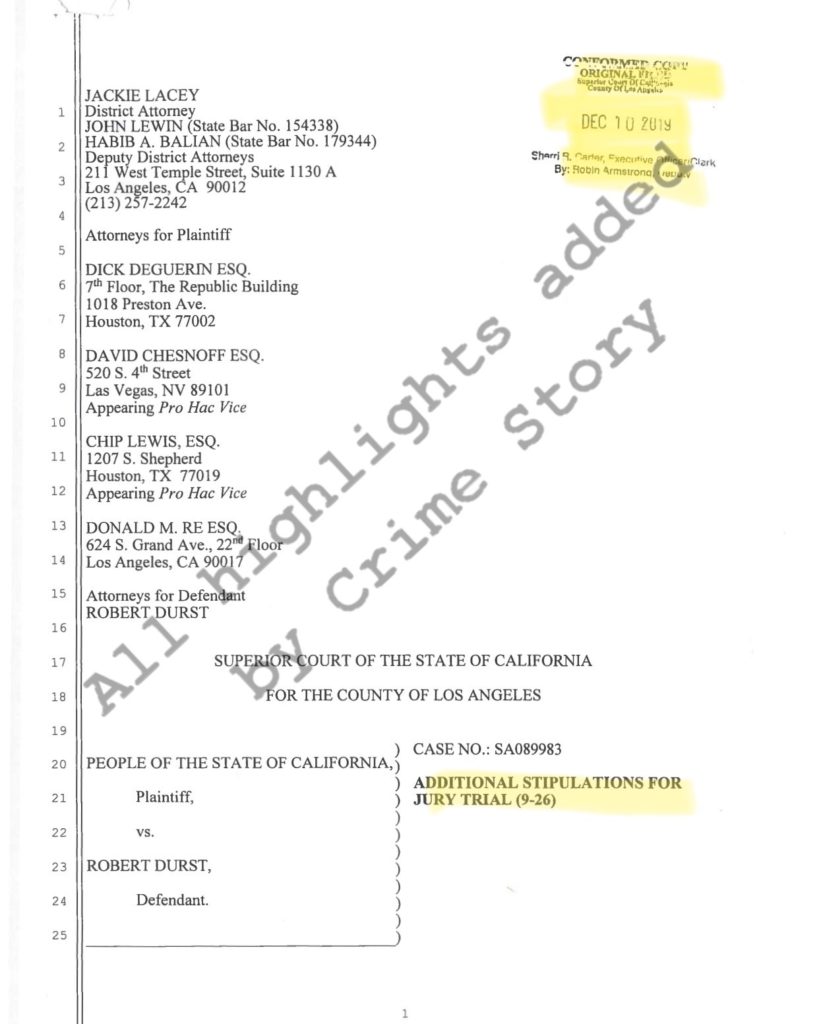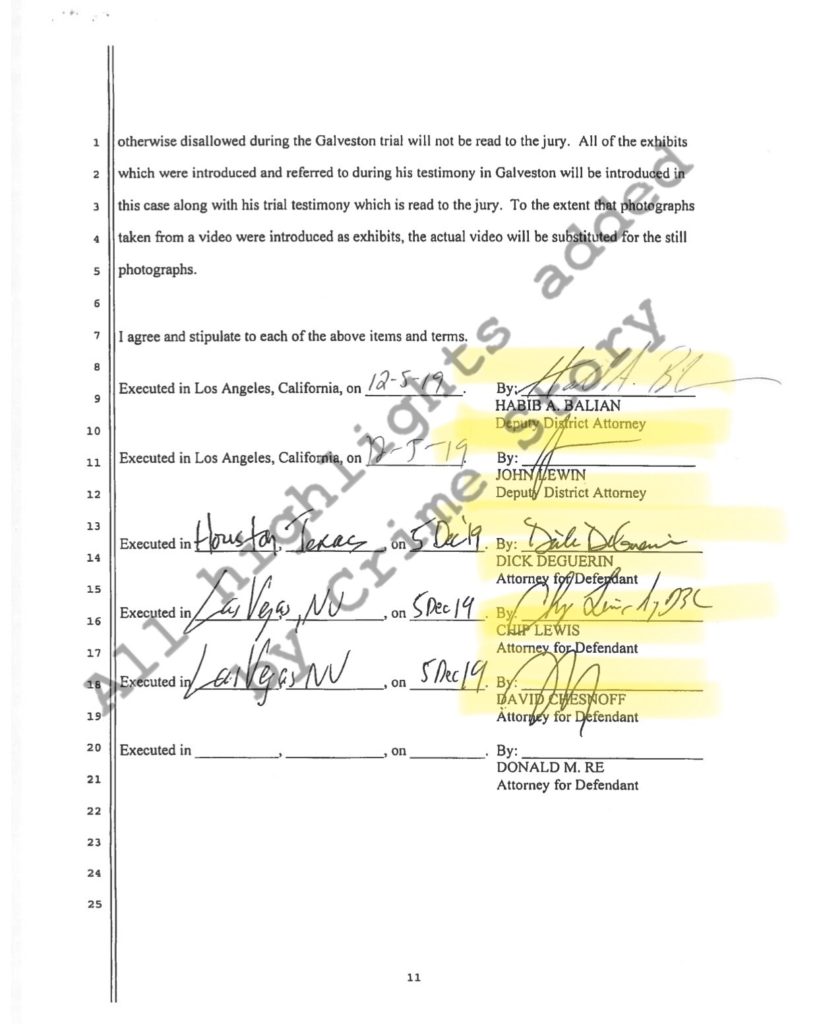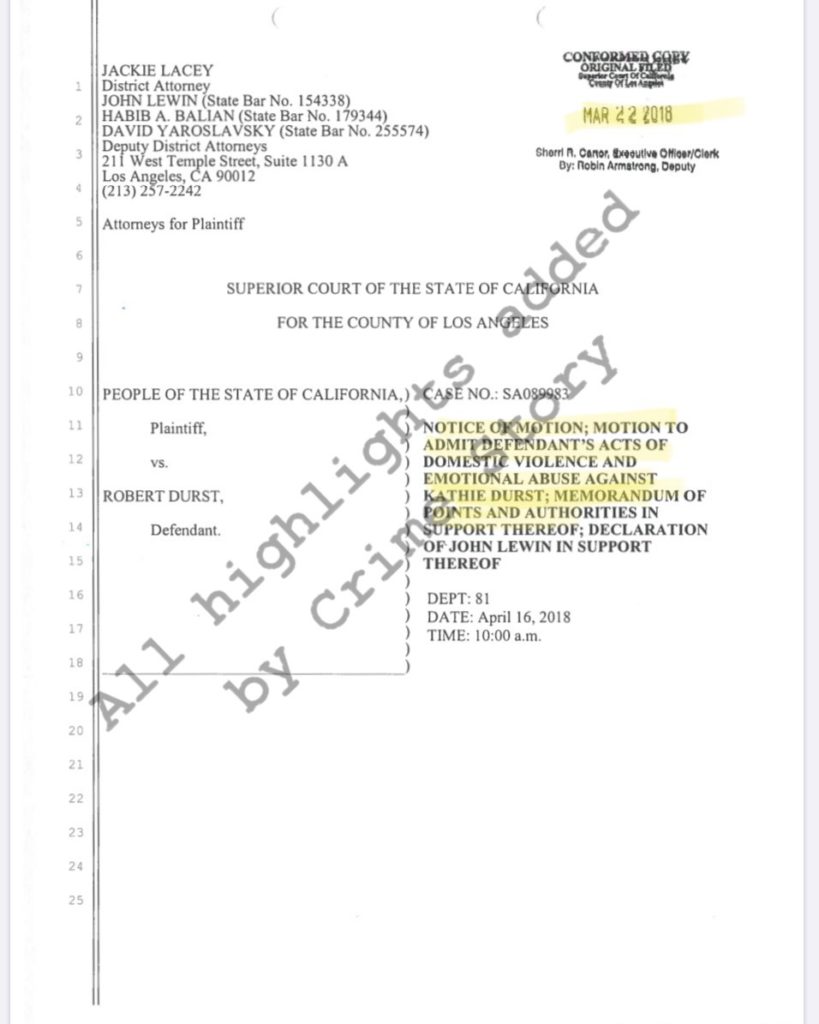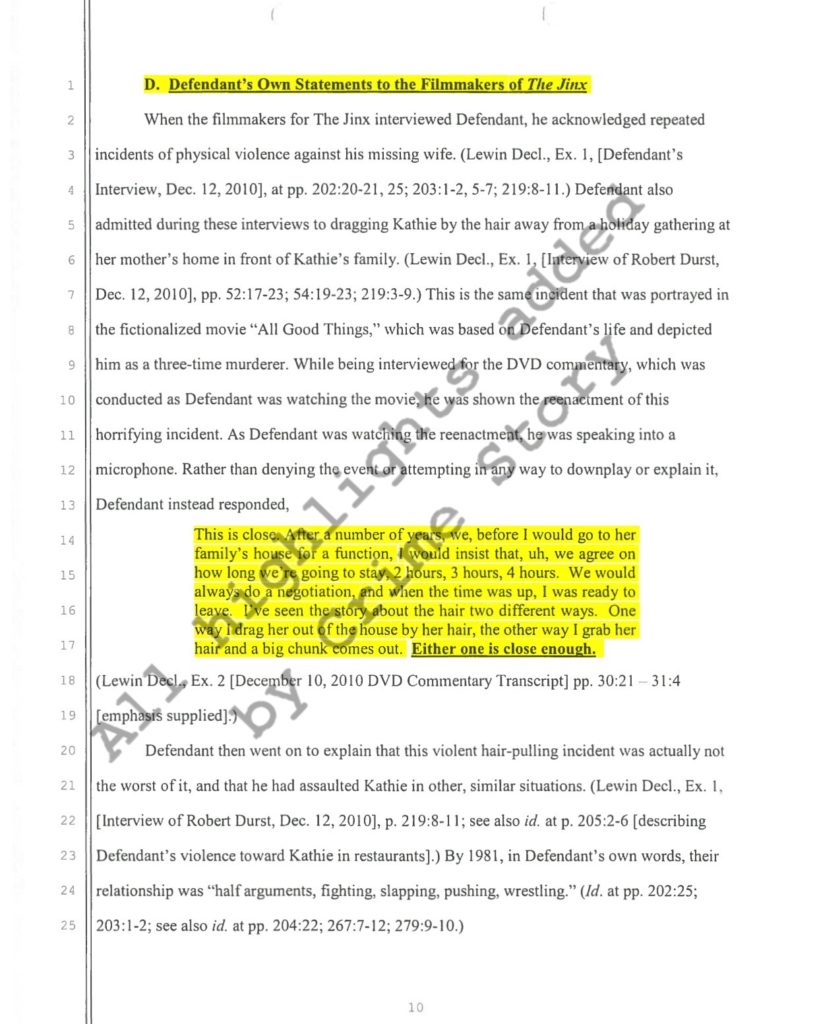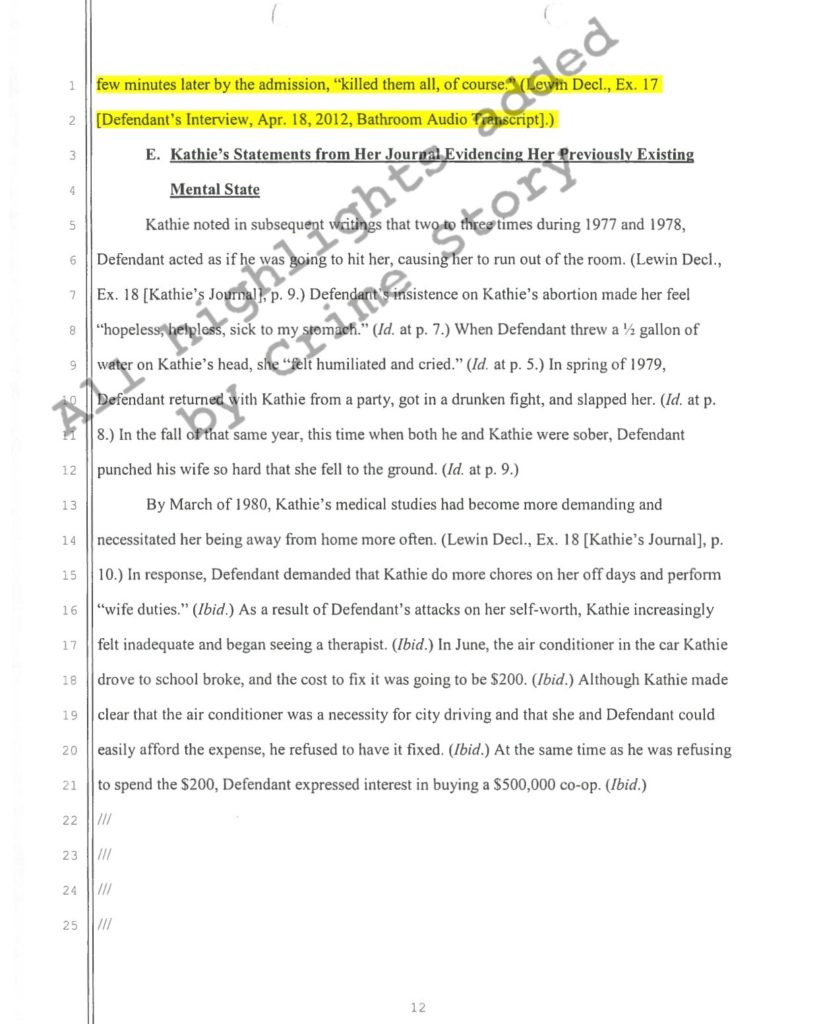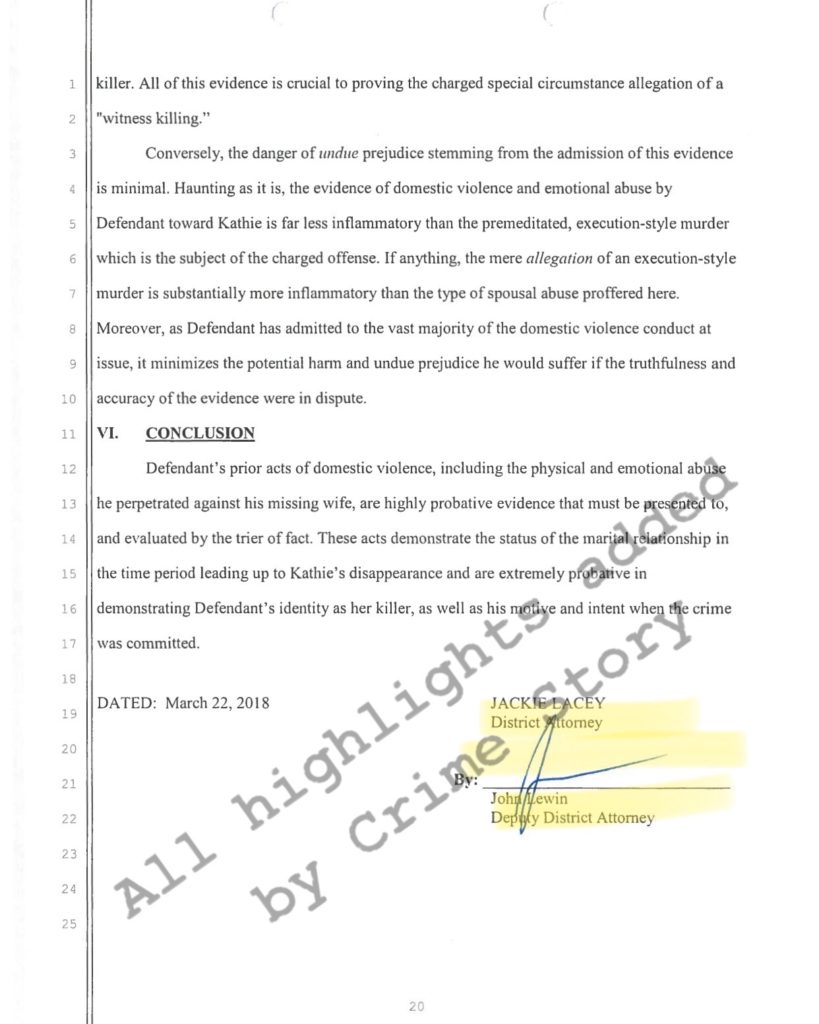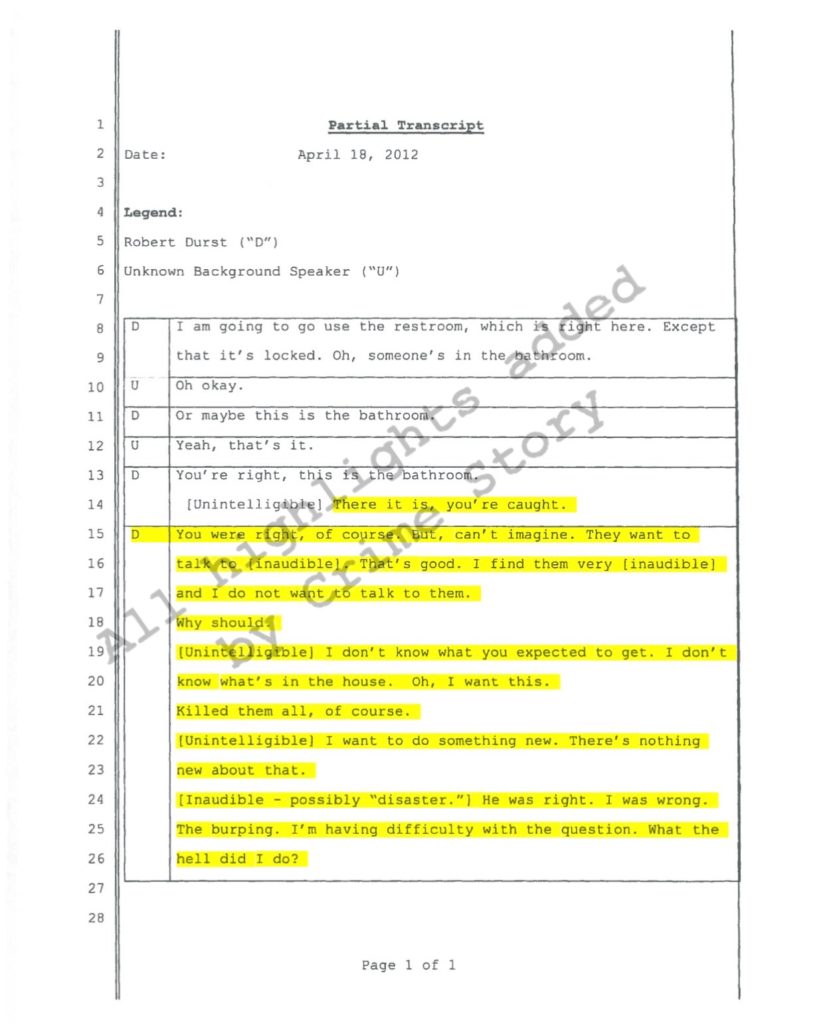Robert Durst has – for the first time – acknowledged that certain audio recordings made by the producers of the HBO documentary series The Jinx are “true and accurate,” including the now infamous recording of Durst muttering to himself, “Killed them all, of course.” The defense’s acknowledgement came to light in an examination by Crime Story reporters of stipulation documents filed jointly by defense and prosecuting attorneys as part of pre-trial motions on December 10, 2019. Durst’s trial for the murder of Susan Berman is scheduled to begin in March.
The stipulation covers all recordings made by Durst in interviews on December 11-13, 2010 and on April 18, 2012. Prosecutors will play the interviews for the jury during Durst’s trial. In the stipulation document, the defense and prosecution agree that the portions of those:
…interviews that the People have played and/or will play in court during this trial, are true and accurate copies of those interviews. No portions of those interviews, either video or audio, were edited, altered, or modified in any way. This includes the audio of statements defendant Robert Durst made on April 18, 2012 when he was inside the bathroom, as well as statements he made while watching All Good Things for the purpose of making a DVD Commentary.
From Additional Stipulations for Jury Trial (9-26) in The People vs. Robert Durst, December 10, 2019 (See document images at the bottom of this article.)
It was during the April 18, 2012 interview that filmmakers Andrew Jarecki and Marc Smerling confronted Durst with the fact that his handwriting and misspelling on an envelope sent to Berman by Durst was nearly identical to the handwriting and misspelling on the envelope of a note sent to the Beverly Hills Police Department stating that there was a “cadaver” at Berman’s address. (The note led to the discovery of Berman‘s body; she had been shot in the back of the head at point-blank range.) In that interview, when confronted with similarities between the two pieces of handwriting, Durst suddenly began burping and then denied that he had written the so-called “cadaver note and envelope.”
The raw footage and audio of the “cadaver note and envelope” interview will be played for the jury by the prosecution during Durst’s trial.
On December 24, 2019, as previously reported by Crime Story and in the New York Times, Durst’s attorneys finally acknowledged that he did, in fact, write the “cadaver note and envelope.”
The stipulation documents recently reviewed by Crime Story reporters also refer to a recording made when Durst was “inside the bathroom” — raw audio of Durst captured immediately after the above-referenced interview with the filmmakers, when Durst broke away from the interview crew to use the bathroom. Both Durst and the filmmakers were apparently unaware that the wireless lavalier microphone Durst wore when he left the room was still live or “hot.” Below is the full text of Durst’s bathroom comments, according to a transcript of that recording entered into evidence by the prosecution.
There it is, you’re caught.
You were right, of course. But, can’t imagine. They want to talk to [inaudible]. That’s good. I find them very [inaudible] and I do not want to talk to them.
Why should.
[Unintelligible] I don’t know what you expected to get. I don’t know what’s in the house. Oh, I want this.
Killed them all, of course.
[Unintelligible] I want to do something new. There’s nothing new about that.
[Inaudible – possibly “disaster.”) He was right. I was wrong. The burping. I’m having difficulty with the question. What the hell did I do?
Source: Motion to Admit Defendant’s Acts of Domestic Violence and Emotional Abuse Against Kathie Durst; Memorandum of Points in Support Thereof; Exhibit 17, March 22, 2018 (See document images at bottom of this article)
In an article published on April 24, 2019, the New York Times suggested that, along with Durst, the documentary series The Jinx would be “also be on trial.” The defense, however, has been unsuccessful in making fourth, fifth and sixth amendment arguments for the exclusion of evidence turned over to the prosecution by the filmmakers.
The defense’s and prosecution’s joint stipulation acknowledges that the filmmakers of The Jinx:
…did, in fact, make edits and modifications of this audio and video footage (including extensive editing of the bathroom audio) in the versions which appeared in “The Jinx,” the miniseries which was aired on HBO.
From Additional Stipulations for Jury Trial (9-26) in The People vs. Robert Durst, December 10, 2019 (See document images at the bottom of this article.)
However, the prosecution will not be offering any of the edited versions of The Jinx as evidence. So, while the filmmakers may well be called to testify, it’s hard to see how the defense will be able to put the film “on trial“ when their client has acknowledged that all of the recordings that the jury will see and hear are “true and accurate.”
In an equally bizarre development, the defense has acknowledged that the DVD commentary Durst recorded for the feature film All Good Things, directed by Jarecki and co-written by Smerling, is also “true and accurate.” Durst reached out to the filmmakers after seeing that film, and agreed to record the commentary. In fact, it was that initial contact by Durst that led the filmmakers to begin the process of making The Jinx.
While the jurors will not watch The Jinx documentary, they will watch the entirety of All Good Things in order to give them context for the DVD commentary which they will also hear.
The first two-thirds of All Good Things tells the story of a relationship between a man, David Marks (played by Ryan Gosling) and a woman, Katie McCarthy (played by Kirsten Dunst), thinly veiled representations of Robert Durst and his first wife Kathleen (nee McCormack). In the film, David is possessive and violent towards Katie. As Katie becomes increasingly desperate to extricate herself from the relationship, she suddenly goes missing. Katie’s increasingly desperate circumstances mirror many of the documented events leading up to the disappearance of Kathy Durst.
The DVD commentary for the film captures a conversation between Durst and Jarecki as they watch All Good Things together. As the film plays, Durst comments on how closely the film matches Durst’s real life experiences. About half way through the film, Gosling’s character David is at a family gathering with Dunst’s character Katie and her family. David grows frustrated and wants to leave. Katie tells him she’s not going anywhere. David returns to his car and waits, his irritation building. Suddenly, he gets out of his car, marches back into the house, grabs Katie by the hair and – to the horror of her family – drags her from the house.
In the commentary under this scene, Durst acknowledges:
“This is close. After a number of years, before I would go to her family’s house for a function I would insist that we agree on how long we were going to stay: two hours, three hours, four hours. We would do a negotiation. When the time was up, I was ready to leave. I’ve seen the story about the hair two different ways: One way I would drag her out of the house by her hair; the other way I would grab her hair and a big chunk comes out. Either one is close enough.”
All Good Things DVD Commentary beginning at 47:08
In another scene, Katie flees a fight/beating from David and bangs on a neighbor’s window as rain pours on her. In the DVD commentary on this scene, Durst tells Jarecki:
“This is more-or-less accurate. I don’t know why she would go in our neighbor’s window as opposed to go to their door. And it was pouring, and we were have a wrestling-shoving-type fight, and she ran out on the terrace and ran to their apartment. Said she was afraid to go home. So she didn’t want to go home. She doesn’t have to go home. … I didn’t really care one way or another what she did. It was late and I was just tired.”
All Good Things DVD Commentary beginning at 51:05
Although All Good Things never explicitly shows David, the ersatz Durst character, committing any crimes, the film strongly implies that David is responsible for the disappearance of his wife. It also suggests that David/Durst was responsible for the subsequent murders of his best friend from college and his neighbor in Texas – thinly veiled versions of actual victims Susan Berman and Morris Black. Despite these damning intimations, the strongest objection that Durst makes in the DVD commentary is to the film’s implication that Durst bludgeoned his dog Igor with a shovel.
Durst: This made me feel bad about the movie, Andrew. I mean the idea that I could kill Igor, I don’t like.
Jarecki: Well, there was a lot of discussion about you having had a lot of dogs over the years, a bunch were named Igor. But maybe… someone said to us at one point that you had seven dogs over 10 years or something.
Durst: No, we had two Igors before the Igor that lasted forever. One of them got run over and one of them, when he was a puppy, went out and the second one ate an apple core. The apple core got stuck in his gut. We took him and had an operation done on him and he died.
All Good Things DVD Commentary beginning at 1:04:09
Before playing Durst’s commentary, the prosecution will be allowed to screen the entirety of All Good Things for the jury as context for that commentary.
Durst’s interview responses, his “hot mic” utterances, and his DVD commentary recordings represent just a small portion of the evidence in the People of California’s case against Robert Durst for the murder of Susan Berman. But Durst’s recent acknowledgement of their “true and accurate” nature – especially when combined with his admission that he wrote the so-called “cadaver note” – only deepens the mystery of how his defense team will establish reasonable doubt of his guilt in the minds of a jury.
Crime Story has previously published eight installments in a series of articles about the hearings leading up to the murder trial of Robert Durst. You may click on the hyperlinked titles to read Two Hearings: Robert Durst and Armon Nelson, While Robert Durst Flips Through Photos, Robert Durst Fades Away, Robert Durst and the Inequity of Judicial Time, Robert Durst’s Warrior in Court, Robert Durst Stares into the Camera, Robert Durst’s Lawyer Gets a Compliment, and Robert Durst: You Can’t Unring the Bell. We also published a news story about Durst’s stipulation to key evidence (his authorship of the so-called “cadaver note” and “dig note”) here and presented a podcast discussion of the case here.
Attached is a gallery of images referenced in this article. All highlights were made by Crime Story Editors.


